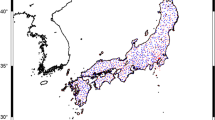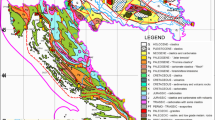Abstract
It is commonly accepted that the horizontal-to-vertical spectral ratio (HVSR) technique enables the detection of the fundamental resonance frequency (\(f_{\text{HVSR}}\)) of a given site. The utility of this \(f_{\text{HVSR}}\) is analyzed using the nonlinear regression relationships between \(f_{\text{HVSR}}\) and bedrock depth (\(h\)). The derived relationships are mostly site-specific, so that the present paper consists of two main parts. The first is a literature review for the available empirical relationships between \(f_{\text{HVSR}}\) and \(h\). The aim of this part is to highlight the practical limitations of these established relationships and to make fair comparisons. The second is to generate new relationships, taking advantage of the very wide range of available lithological, geophysical, and geotechnical borehole drilling data of the 697 KiK-NET seismic stations in Japan. For this purpose, HVSR are calculated using 10,000 weak earthquakes or linear events recorded at KiK-NET stations to determine the \(f_{\text{HVSR}}\) and correlate it with the corresponding \(h\). The overlying layers/bedrock interface falling within sedimentary, igneous, or metamorphic layers significantly affect the derived frequency–depth relationships. In addition, these relationships are strongly reproduced by the \(V_{\text{p}} /V_{\text{s}}\) ratio of the bedrock in the range of 1.6–2.2. Interestingly, it is found that \(f_{\text{HVSR}}\) less than 1 Hz corresponding to \(h\) more than 100 m leads the trend of the overall frequency–depth relationship.













Similar content being viewed by others
References
Anbazhagan, P., & Sitharam, T. G. (2009). Spatial variability of the depth of weathered and engineering bedrock using multichannel analysis of surface wave method. Pure and Applied Geophysics,166, 409–428. https://doi.org/10.1007/s00024-009-0450-0. (0033-4553/09/030409-20).
Bard, P. Y., & SESAME team. (2004). Guidelines for the implementation of the H/V spectral ratio technique on ambient vibrations: Measurements, processing and interpretation, SESAME European research project, WP12—Deliverable D23. 12.
Bindi, D., Parolai, S., Spallarossa, D., & Cattaneo, M. (2000). Site effects by H/V ratio: Comparison of two different procedures. Journal of Earthquake Engineering,4, 97–113.
Birgören, G., Özel, O., & Siyahi, B. (2009). Bedrock depth mapping of the coast south of İstanbul: Comparison of analytical and experimental analyses. Turkish Journal of Earth Sciences,18, 315–329. https://doi.org/10.3906/yer-0712-3.
Castro, R. R., Mucciarelli, M., Pacor, F., & Petrungaro, C. (1997). S-wave site response estimates using horizontal-to-vertical spectral ratios. Bulletin of the Seismological Society of America,87, 256–260.
Del Monaco, F., Tallini, M., De Rose, C., & Durante, F. (2013). HVNSR survey in historical downtown L’Aquila (central Italy): Site resonance properties vs. subsoil model. Engineering Geology,158, 34–47. https://doi.org/10.1016/j.enggeo.2013.03.008.
Delgado, J., Casado, C. L., Estévez, A., Giner, J., Cuenca, A., & Molina, S. (2000a). Mapping soft soils in the Segura river valley (SE Spain): A case study of microtremors as an exploration tool. Journal of Applied Geophysics,45, 19–32.
Delgado, J., Casado, C. L., Giner, J., Estévez, A., Cuenca, A., & Molina, S. (2000b). Microtremors as a geophysical exploration tool: Applications and limitations. Pure and Applied Geophysics,157, 1445–1462.
Ducellier, A., Kawase, H., & Matsushima, S. (2013). Validation of a new velocity structure inversion method based on horizontal-to-vertical (H/V) spectral ratios of earthquake motions in the Tohoku Area, Japan. Bulletin of the Seismological Society of America,103(2A), 958–970.
Fäh, D., Kind, F., & Giardini, D. (2001). A theoretical investigation of average H/V ratios. Geophysical Journal International,145, 535–549.
Fairchild, G.M., Lane, J.W., Voytek, E.B., & LeBlanc, D.R. (2013). Bedrock topography of western Cape Cod, Massachusetts, based on bedrock altitudes from geologic borings and analysis of ambient seismic noise by the horizontal-to-vertical spectral-ratio method, U.S. Geological Survey Scientific Investigations Map 3233, 1 sheet, maps variously scaled, p 17. Pamphlet, on one CD–ROM. http://pubs.usgs.gov/sim/3233. Accessed 20 Feb 2017.
FEMA 222A. (1994). NEHRP recommended provisions for the development of seismic regulations for new buildings, 1994 edition, Part 1—provisions, Federal Emergency Management Agency
FEMA 450. (2004). NEHRP recommended provisions for seismic regulations for new buildings and other structures, 2003 edition, part 1—provisions (p. 356). National Institute of Building Sciences, Washington, D.C.: Building Seismic Safety Council.
Field, E. H. (1996). Spectral amplification in a sediment-filled valley exhibiting clear basin-edge-induced waves. Bulletin of the Seismological Society of America,86, 991–1005.
Field, E. H., & Jacob, K. (1993). The theoretical response of sedimentary layers to ambient seismic noise. Geophysical Research Letters,20–24, 2925–2928.
García-Jerez, A., Piña-Flores, J., Sánchez-Sesma, F. J., Luzón, F., & Perton, M. (2016). A computer code for forward computation and inversion of the H/V spectral ratio under the diffuse field assumption. Computers & Geosciences,97, 67–78.
Harutoonian, P., Leo, C. J., Tokeshi, K., Doanh, T., Castellaro, S., Zou, J. J., et al. (2013). Investigation of dynamically compacted ground by HVSR-based approach. Soil Dynamics and Earthquake Engineering,46, 20–29. https://doi.org/10.1016/j.soildyn.2012.12.004.
Hinzen, K. G., Weber, B., & Scherbaum, F. (2004). On the resolution of H/V measurements to determine sediment thickness, a case study across a normal fault in the lower Rhine Embayment, Germany. Journal of Earthquake Engineering,8(6), 909–926. https://doi.org/10.1080/13632460409350514.
IBC. (2009). The international building code, International Code Council, ISBN: 978-1-58001-725-1 (soft-cover edition), ISBN: 978-1-58001-724-4 (loose-leaf edition) , pp 752.
Ibs-von Seht, M., & Wohlenberg, J. (1999). Microtremors measurements used to map thickness of soft soil sediments. Bulletin of the Seismological Society of America,89, 250–259.
Kawase, H., Mori, Y., & Nagashima, F. (2018). Difference of horizontal-to-vertical spectral ratios of observed earthquakes and microtremors and its application to S-wave velocity inversion based on the diffuse field concept. Earth, Planets and Space,70, 1. https://doi.org/10.1186/s40623-017-0766-4.
Kawase, H., Sánchez-Sesma, F. J., & Matsushima, S. (2011), Application of the H/V spectral ratios for earthquake and microtremor ground motions. In: 4th IASPEI/IAEE international symposium: effects of surface geology on seismic motion, August 23–26, (2011), University of California Santa Barbara
Lachet, C., & Bard, P. Y. (1994). Numerical and theoretical investigations on the possibilities and limitations of Nakamura’s technique. Journal of Physics of the Earth,42, 377–397.
Lermo, J., & Chavez-Garcia, F. J. (1993). Site effect evaluation using spectral ratios with only one station. Bulletin of the Seismological Society of America,83, 1574–1594.
Lermo, J., & Chavez-Garcia, F. J. (1994). Are microtremors useful in site response evaluation? Bulletin of the Seismological Society of America,84, 1350–1364.
Lontsi, A. M., Sánchez-Sesma, F. J., Molina-Villegas, J. C., Ohrnberger, M., & Krüger, F. (2015). Full microtremor H/V(z, f) inversion for shallow subsurface Characterization. Geophysical Journal International,202, 298–312. https://doi.org/10.1093/gji/ggv132.
Maeda, T. (2004), Observatory shed effect on strong motion records identified by micro-tremor measurement, in Proceedings of the thirteenth world conference on earthquake engineering, Vancouver, British Columbia, Canada, Paper No. 568
Miller, R. D., Xia, J., Park, C. B., & Ivanov, J. (1999). Multichannel analysis of surface waves to map bedrock. The Leading Edge,18(12), 1392–1396.
Mucciarelli, M. (1998). Reliability and applicability of Nakamura’s technique using microtremors on the ground surface: an experimental approach. Journal of Earthquake Engineering,2, 625–638.
Nakamura, Y. (1989). A method for dynamic characteristics estimations of subsurface using microtremors on the ground surface. Q Rep RTRI Jpn,30, 25–33.
Nakamura, Y. (2000), Clear identification of fundamental idea of Nakamura’s technique and its application, in Proceedings of the XII world conference earthquake engineering. Auckland, New Zeeland, 8 pp
Nath, S.K. (2007). Seismic microzonation framework—principles and applications, in Proceedings of the workshop on microzonation, Indian Institute of Science, Bangalore, 26–27 June 2007, India, pp. 9–35.
Nogoshi, M., & Igarashi, T. (1970). On the propagation characteristics estimations of subsurface using microtremors on the ground surface. Journal of the Seismological Society of Japan,23, 264–280.
Nogoshi, M., & Igarashi, T. (1971). On the amplitude characteristics of microtremor (Part 2). Journal of the Seismological Society of Japan,24, 26–40.
Özalaybey, S., Zor, E., Ergintav, S., & Tapırdamaz, M. C. (2011). Investigation of 3-D basin structures in the İzmit Bay area (Turkey) by single-station microtremor and gravimetric methods. Geophysical Journal International,186, 883–894. https://doi.org/10.1111/j.1365-246X.2011.05085.x.
Parolai, S., Bormann, P., & Milkert, C. (2002). New relationships between Vs, thickness of sediments, and resonance frequency calculated by the H/V ratio of seismic noise for Cologne Area (Germany). Bulletin of the Seismological Society of America,92, 2521–2527.
Parolai, S., Richwalski, S. M., Milkereit, C., & Bormann, P. (2004). Assessment of the stability of H/V spectral ratios from ambient noise and comparison with earthquake data in the Cologne area (Germany). Tectonophysics,390, 57–73.
Sánchez-Sesma, F. J., Rodríguez, M., Iturrarán-Viveros, U., Luzón, F., Campillo, M., Margerin, L., et al. (2011). A theory for microtremor H/V spectral ratio: application for a layered medium. Geophysical Journal International,186, 221–225.
Satoh, T., Kawase, H., & Matsushima, S. (2001). Differences between site characteristics obtained from microtremors, S-waves, P-waves and codas. Bulletin of the Seismological Society of America,91, 313–334.
Spica, Z. J., Perton, M., Nakata, N., Liu, X., & Beroza, G. C. (2018). Site characterization at Groningen gas field area through joint surface-borehole H/V analysis. Geophysical Journal International,00, 1–10. https://doi.org/10.1093/gji/ggx426.
Sun, C. G. (2014). Earthquake engineering bedrock based on the shear wave velocities of Rock Strata in Korea. The Journal of Engineering Geology,24(2), 273–281. https://doi.org/10.9720/kseg.2014.2.273.
Tün, M., Pekkan, E., Özel, O., & Guney, Y. (2016). An investigation into the bedrock depth in the Eskisehir Quaternary Basin (Turkey) using the microtremor method. Geophysical Journal International,207(1), 589–607. https://doi.org/10.1093/gji/ggw294.
Yamanaka, H., Takemura, M., Ishida, H., & Niwa, M. (1994). Characteristics of long-period microtremors and their applicability in exploration of deep sedimentary layers. Bulletin of the Seismological Society of America,84, 1831–1841.
Yoshimura, C., Hibino, H., Uchiyama, Y., Maeda, T., Kurauchi, N., & Aoi, S. (2003), Vibration characteristics of the observation house at KiK-net Hino, Japan Earth and Planetary Science Joint Meeting (in Japanese with English abstract).
Acknowledgements
The author is very grateful to the National Research Institute for Earth Science and Disaster Prevention (NIED) for making the valuable KiK-NET data available. The author appreciates the valuable and constructive comments and suggestions from the editor and the reviewers.
Author information
Authors and Affiliations
Corresponding author
Additional information
Publisher's Note
Springer Nature remains neutral with regard to jurisdictional claims in published maps and institutional affiliations.
Rights and permissions
About this article
Cite this article
Thabet, M. Site-Specific Relationships between Bedrock Depth and HVSR Fundamental Resonance Frequency Using KiK-NET Data from Japan. Pure Appl. Geophys. 176, 4809–4831 (2019). https://doi.org/10.1007/s00024-019-02256-7
Received:
Revised:
Accepted:
Published:
Issue Date:
DOI: https://doi.org/10.1007/s00024-019-02256-7




